Winning tip: Hiking in Amorgos, Cyclades
As well as the azure bays and its role in Luc Besson’s The Big Blue, Amorgos is also renowned for its hiking trails, which not only connect the island’s villages but also provide access to ecclesiastical and natural landmarks. Start at Hora, the capital of the island, and walk towards the landmark of Amorgos, the Greek-Orthodox monastery of Panagia Hozoviotissa. Built by Byzantine emperor Alexius Comnenus I in the 11th century, this whitewashed monastery is wedged into a cliff face 300 metres above the sea. Climb the nearly 300 steps, walk through the low marble doorway and take the staircase that leads to the chapel where treasures and icons are kept. You will be rewarded with a vertiginous yet panoramic view of the Mediterranean, complimentary rose-flavoured loukoumi (Greek Turkish delight) and psimeni raki (raki with honey and spices) offered by the monks. From there, descend towards the pebble beach of Agia Anna. Here the waves splash against a rock which a chapel of the same name is built on. It’s then time to dive into the deep blue Aegean.
Alex Chatziagorakis
Karpathos, Dodecanese
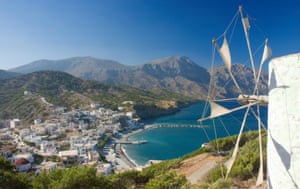
The windmills in Olympos are a feature of Karpathos. Photograph: Franz Pritz/Getty Images
The largest Dodecanese island is largely unknown to Brits. You can fly there but not directly from the UK. Better to take the ferry from Rhodes or Crete as we did and head for Diafani, where getting around is mostly by boat or on foot. We were enchanted by the lack of tourist trappings as local life carried on around us. As visitors we found ourselves welcomed with gifts of pomegranates, just-caught whitebait and freshly baked bread. While we were drinking coffee at a cafe on the water’s edge, a local fisherman invited us onto his caïque and took us on a spectacular journey to a beach where we found ourselves alone and surrounded by undisturbed centuries-old ruins. As we swam, our boatman fished for octopus, then barbecued it for us, having first shooed the goat from the stone table. Inland we visited Olympos, courtesy of the free loan of our hotel owner’s car. The remotest village on the island, and only recently accessible by road, it’s a place where traditional costumes and customs still persist, and time seemed, like its iconic windmills, to stand still.
William Chosen
Kastellorizo
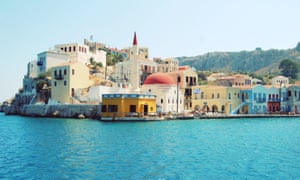
Photograph: Cecilia Lindstrom
Kastellorizo, a mile off the Turkish coast, is a colourful and picturesque island with a tumultuous past. Originally colonised by the Dorian Greeks, the island was later occupied by Egypt, Italy and the Ottoman empire, all of which is evident in the capital’s rich architectural legacy. Pastel-coloured Anatolian-style houses are arranged around a small fishing harbour lined with tavernas. Dotted on the hillside are a church and a cathedral, an Ottoman mosque, monasteries and castles. The ruins of an ancient acropolis lies on the western outskirts of town. A promenade on the steep streets and lanes provides abundant delight and surprise as well as breathtaking views of the Mediterranean. A small family-friendly beach west of the harbour is excellent for swimming. The island’s remote location on the fringes of the Dodecanese has left it relatively undisturbed by tourists, making it an ideal getaway centred on food, recuperation and culture. The island is easily reached by boat from Rhodes or Kas.
Cecilia Lindstrom
Lipsi, Dodecanese
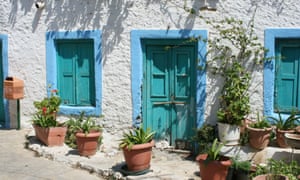
Rena’s Rooms
I first met Rena in 1992. I was a teenager then, reluctantly dragged by my mother on holiday to a then off-the-beaten track island. With its low hills, unspoiled beaches and welcoming people, Lipsi was the hidden gem of the Dodecanese. Rena Rooms is at the edge of the small “town” of Lipsi, the only settlement on the island, and the rooms overlook Liendou beach. The views are so calming, and waking up to the sea just below your balcony with only the singing of birds, the bells of goats and sweet wild thyme and oregano fragrance in the air is just breathtaking. I have visited the island and Rena on and off for 26 years, and she has slowly planted the most beautiful succulent garden of grasses, cactuses, herbs and olive trees, which spills from the grounds to the edge of the beach. Rena is one of the warmest people I have met, and her husband and one of her sons run boat trips.
Natalia Charogianni
Abandoned sulphur mines of Milos, Cyclades
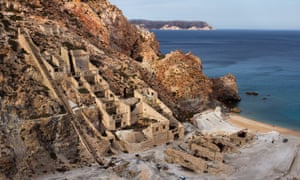
Photograph: Getty Images
There can be no more breathtaking backdrop to a dip in the Aegean than the abandoned sulphur mine of Milos. The stunning bay of Paliorema can be accessed via a dirt road, although the scramble down the cliff to the golden shingle is not for the faint-hearted. Hire a 4×4 to get as close as possible. Once at the beach, you can wander freely around the abandoned buildings, where it appears the miners may be back at any moment to start work. Follow up your visit at the Mining Museum in Adamas, which includes a video about workers in the sulphur mine before it was permanently closed in 1978. Milos’s charms are only enhanced by the fact that it has not relied on tourism for survival like some of its better-known neighbours.
Sarah Leppard
The Aegean Sea: island-hopping
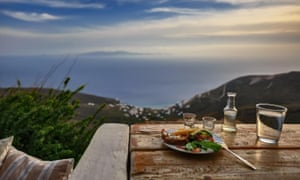
A tsipouro drink with meze and great view to the Aegean in Tinos. Photograph: Alamy
The Aegean islands – and in particular those of the Cyclades such as Mykonos, Naxos, Syros, Tinos and Andros – are a great starter pack for Greek island newbies, yet no less attractive to those already won over by the sun, sea, fabulous views and wonderful food and hospitality that the islands are known for. They are easily accessible direct by air from a number of UK airports – fly to Mykonos in around four hours for the full-on luxury, cocktail-sipping whitewash experience. Or make a Greek island cruise of it by taking the ferry from Athens. With the choice of two ports close to Athens and both fast and slow ferry options, the added option of island hopping is irresistible. In around 4½ hours (two hours on a faster Seajet) you can be in Tinos, savouring the local produce it is known for. Time your visit with the artichoke festival in May or the raki festival in September and enjoy a locally brewed beer listening to jazz by the waterfront. Or you could be in Andros, hiking the well-maintained ancient paths, or spectacular Syros, with its elegant architecture – sitting among it if you’re there during the intimate annual film festival in July. They are so closely grouped, you can even base yourself on one island and do day trips, say to Mykonos when you tire of the fabulous sandy beaches on Naxos. The ferries are modern, safe, frequent and relatively cheap. For the most economical journey, leave from the port of Rafina and take a conventional ferry.
fetarm
Donoussa, Cyclades
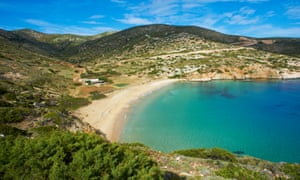
Photograph: Getty Images
Donoussa is the quietest of the smaller Cyclades islands, hidden behind much larger Naxos. Traditionally described as off the beaten track, it has reinvigorated itself in recent years as younger people move back from Athens to work in family businesses. There are some great new restaurants, such as To Auli in the main (small) village and an organic beach bar at nearby Kedros bay. An excellent new walking guide (in Greek and English) opens up the hills, while a minibus service will carry you back from the other side of the island on the only road. There are regular ferries from Athens but arrive on the local Express Skopelitis from Naxos for the best experience – this ferry also offers lots of short-journey, island-hopping options.
zephleggin
Hydra, Saronic Islands
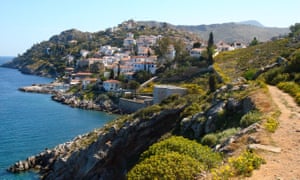
Photograph: Shelley Paterson
Hydra, retreat for chic Athenians, as well as families with children, is just a half-hour ferry hop from the capital. It’s car-free, so you can meander through winding streets or take a donkey ride. Breakfast on mellow coffee with walnut cake or cheesecake while overlooking the marina packed with yachts. Hop on a ferry to whisk you to close-by islands or bob on a dingy up the coast. Next, window shop local painting and silverwork on your way to lunch. Lunch! Try spit-roast lamb with garlicky greens, soft flatbreads and feta salad, which comes without the asking. Nap on a sandy beach. If you do stay the night, breakfast on fried eggs in fruity olive oil.
Shelley Paterson
Kefalonia, Ionian
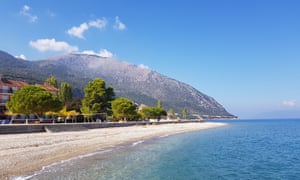
Photograph: Rachel Hughes/Getty Images
Kefalonia is the loveliest of islands: pristine blue-flag beaches, the vibrant greens of sacred, pine-clad Mount Enos, the constant cerulean sky. It is the largest of the Ionian Islands and exploring the mountain roads of its lush interior can provide glorious solitude, even in peak season. We stayed in the friendly, low-key resort of Skala. Ten minutes north is Kaminia beach, a nesting site for loggerhead turtles – the nests marked with tiny wooden barricades by volunteers. Perfect swimming, views of misty Zante and a very Greek kantina serving homemade burgers and feta- garnished salads.
Tony Hulse
Cretan treats for veggies and vegans
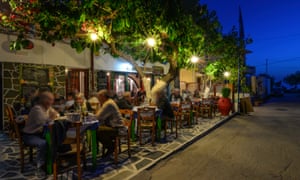
ThirdEye, Paleochora, Crete
Western Crete is an awesome place to visit with magnificent mountains, beautiful beaches and loads of history. Away from the gulf of Chania, tourism is relatively low key. In addition, there are at least two excellent veggie eating places. We discovered Third Eye in Paleochora in 1999 after many years of island hopping and surviving on Greek salad! We’ve returned each year since to enjoy its eclectic mix of dishes. As well as traditional Cretan dishes (such as boureki and moussaka) other dishes are inspired by the owners’ travels in Asia and they use much locally grown produce. The town is lovely, with two beaches and the remains of a Venetian castle. The bus journey from Chania Town provides extraordinary panoramas, as the route crosses the island and climbs into the mountains. Last year we lunched in Chania Town in another long-established family-run vegetarian restaurant To Stachi, a wonderful place to escape from the crowds around the harbour. Advocating Slow Food, this gem is close to the sea and the eastern city walls. Again, it does delicious veggie versions of traditional dishes using local organic produce.
JAHark
Source: 10 great Greek islands: readers’ travel tips | Travel | The Guardian
